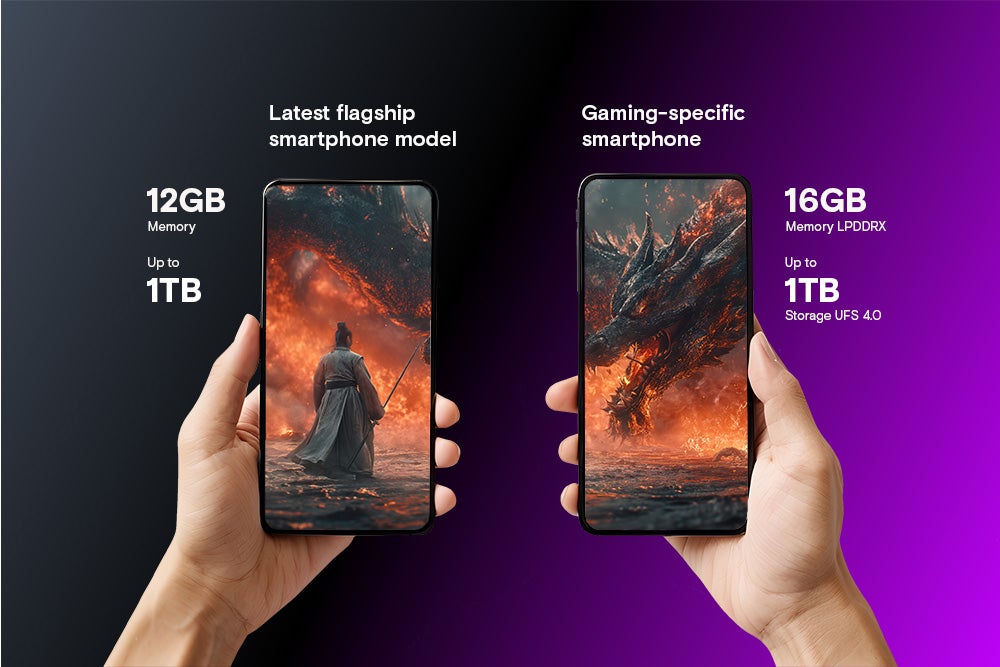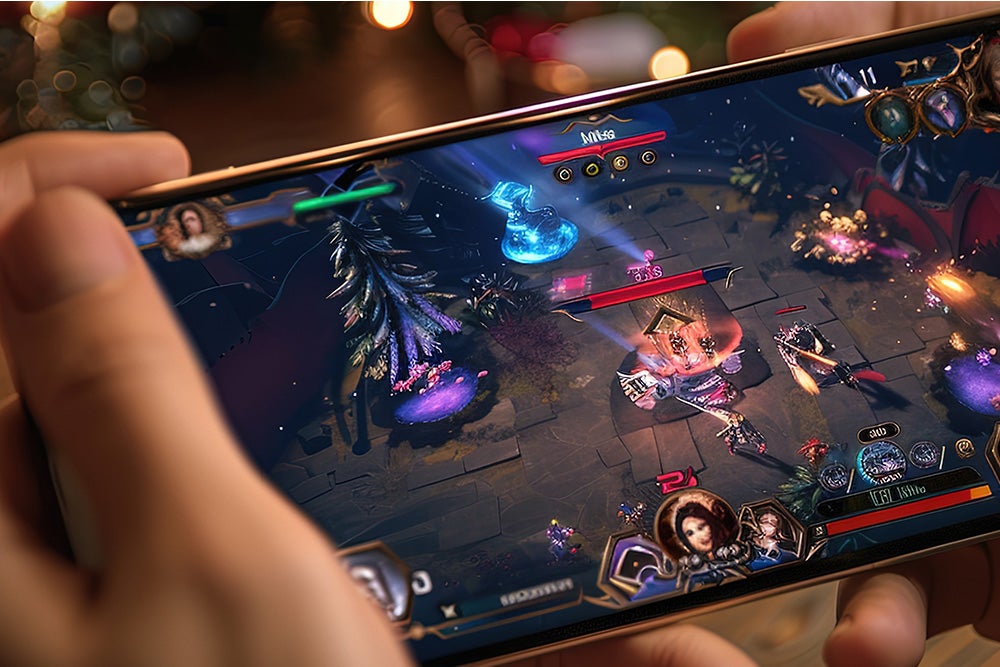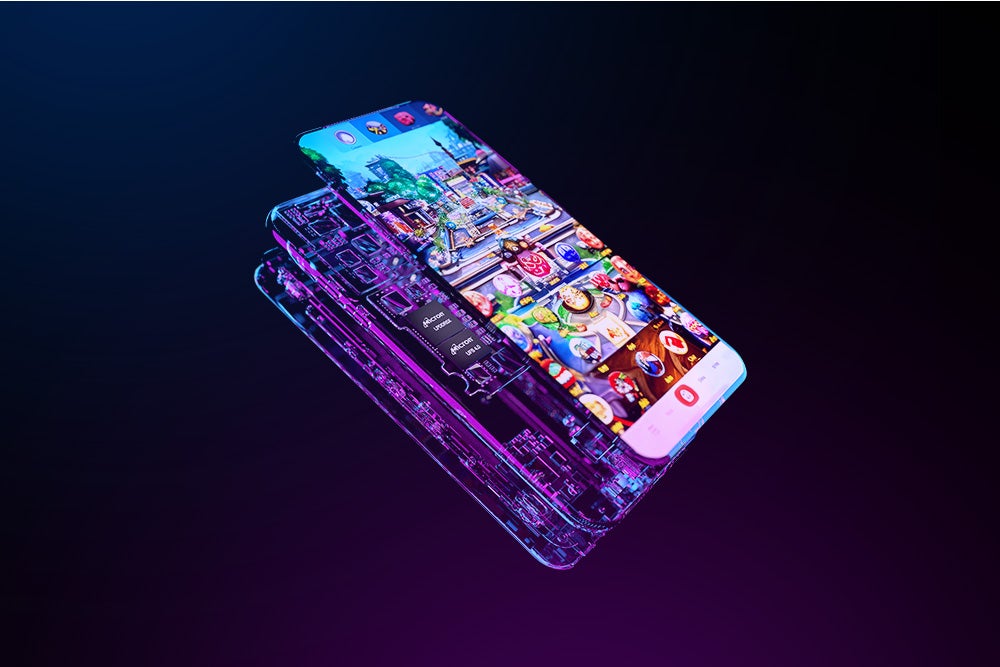- US - English
- China - 简体中文
- India - English
- Japan - 日本語
- Malaysia - English
- Singapore - English
- Taiwan – 繁體中文
Invalid input. Special characters are not supported.
Today, nearly everyone owns a smartphone — they are our modern-day digital companions. Despite their small size, smartphones have the processing power that promises limitless potential while we are on the go. We rely on our smartphones to be our personal assistants, fact checkers and portable entertainment centers.
Smartphones have revolutionized the gaming industry, too, making gaming more accessible and engaging for all— from competitive esports players and streamers in front of a global audience to parents who casually play Candy Crush while waiting in the school pickup line.
People play games during their train commutes, breaks and downtime, making it a fun release from a hectic day. Smartphone manufacturers recognize this increase in consumer behavior toward gaming and are creating devices with superior technical specifications and features. These advanced features are crossing over to popular flagship smartphones that offer OLED displays, high-capacity storage of up to 1TB and long-lasting battery life of up to 25 hours to provide seamless performance on any mobile game.1
Gaming-specific smartphones are also rising to the occasion, namely Asus with the ROG Phone marketed as “built to win” and ZTE’s RedMagic 9S PRO positioned as “The ultimate gaming setup”. These smartphones are designed with technical features such as an AMOLED screen with HDR visuals, internal cooling chambers and super high refresh rates for a high-quality experience.2 These advancements go hand in hand with technology innovation and end user demands for PC-like gaming experiences on mobile devices.

Entering a new era of mobile gaming
Gaming as we know it is changing — gone are the days when gaming was simply a hobby. Ivy League and public colleges are establishing state-of-the-art gaming centers3 and offer majors in game development.4 As of 2023, almost 300 billion mobile apps were downloaded, over half of which were games,5 and the industry boasted almost two billion mobile gamers worldwide6 and generated $140.5 billion in revenue.6
The surge in mobile gaming means that billions of people are engaging in this activity, making it not only an integral part of their daily life but also a cash cow for the economy. In perspective, the combined revenue of the National Football League,7 Major League Baseball8 and National Basketball Association9 squeaks in around $35 billion, nearly one-third of the mobile gaming global revenue. This exponential growth in mobile gaming is reshaping the entertainment landscape while also working hand in hand with advancing technology.
With the evolution of end users’ behavior comes the changing requirements of the hardware for their devices, specifically the internal memory and storage. When Nokia launched the original 1997 mobile game, Snake,10 it required only 1MB of flash memory and 64KB of RAM for the entire phone. Compare that with one of today’s popular titles, Genshin Impact, which can take up 46GB11 of storage. This stark contrast reinforces the importance of high-performance memory and large-capacity storage in today’s mobile devices.
Innovation is key to surprising and delighting end users, who expect their devices to deliver ultrarich experiences. Today this is apparent with the rise and implementation of generative AI (Gen AI) capabilities at the edge. Artificial intelligence (AI) is unlocking an untapped creative aspect within gaming that allows users to access a more personalized experience with dynamic NPCs (non-playable characters), content and storytelling. However, the complex algorithms and vast amounts of data required for Gen AI, combined with high-resolution graphics and extensive game content, creates a robust demand for high-performance memory and high-capacity storage solutions to deliver a seamless and immersive gaming experience.

Maximizing performance: The critical role of memory and storage
Today's mobile games require advanced software and hardware capabilities. When it comes to memory and storage, low-power double data rate (LPDDR) and managed NAND storage embedded in our smartphones are essential for managing the rapid data flow between the GPU and CPU, ensuring smooth gameplay without delays. LPDDR offers low latency, which results in quick response times, making every tap and swipe instant, and keeps players fully immersed.
The latest mobile games require high-capacity universal flash storage (UFS) to store content like maps and updates, further increasing the internal space requirements. High-end and flagship smartphones now offer up to 1TB of internal storage,12 allowing gamers to keep extensive game libraries without worrying about the space available on their device. Additionally, UFS provides faster read/write speeds than older e.MMC storage, ensuring quick game loading, smooth transitions and rapid access to saved progress.
Unlocking the full potential of mobile gaming with Micron memory and storage
With our best-in-class technology powering smartphones, end users can experience the thrill of mobile gaming at its finest. Players can dominate the leaderboards in their favorite MOBA (multiplayer online battle arena) games and explore alternative dimensions in open worlds without thinking about graphics or lag.
Our advanced LPDDR5X and UFS 4.0 technologies are at the forefront of this innovation, offering unparalleled performance and efficiency. LPDRR5X provides ultrahigh data transfer speeds of 9.6 Gbps, significantly lowering power consumption and enhancing bandwidth — all features that ensure mobile devices handle the most demanding games with ease.13 Compared with previous versions, LPDDR5X delivers an additional 16% power savings in heavy usage cases, allowing users to gain additional video playback and battery life to have more game play between charges. UFS 4.0 offers exceptional read and write speeds, drastically reducing load times and providing a seamless gaming experiences.

Powering up the play
For everyone from casual gamers to esports athletes, Micron’s leading memory and storage solutions elevate the smartphone gaming experience. With faster loading times, smoother gameplay, the ability to store enormous gaming libraries and longer battery life for extended play sessions, Micron empowers everyone to unlock their inner gamer to play harder and achieve the victories they seek.
Visit our mobile page to learn more about what our solutions have to offer.
1 Android Authority, Phones with the best battery life for 2024, May 12, 2024, Mitja Rutnik.
2 Republic of Gamers, ROG Phone, ASUS.
3 Alienware Buffalo Esports and Gaming Lounge, Center for Student Involvement (CSI), University of Colorado Boulder
4 Animation Career Review, Top 50 game design schools and colleges in the U.S. — 2024 Ranking, March 13, 2024.
5 Singular, Top 50 mobile games of 2024 (so far), Jan. 14, 2024, John Koetsler.
6 Statista, Mobile gaming market worldwide — statistics & facts, April 24, 2024, J. Clement.
7 The Sporting News, How much does the NFL earn per year? League posted record-high revenue during 2023 season, July 8, 2024, David Suggs.
8 Statista, MLB league revenue 2024, Jul 23, 2024, Christina Gough
9 Statistica, National Basketball Association total league revenue from 2001/02 to 2022/23, July 24, 2024, Statistica Research Department.
10 Mobile Phone Museum, Nokia – 6110.
11 GGRECON, Genshin Impact storage requirements for mobile, PC & PlayStation, May 7, 2024, Tarran Stockton & Dani Cross.
12 Whistleout, How Many GB of Smartphone Storage Do I Need? Dec. 7, 2023, Moe Long.
13 Micron, LPDDR5X: Micron low-power mobile DRAM offers high performance and improved power efficiency for AI experiences, April 2024, Ross Dermott.
14 Micron, World's most compact UFS package enabling next-generation phone designs and larger batters, Infographic PDF, 2024.

